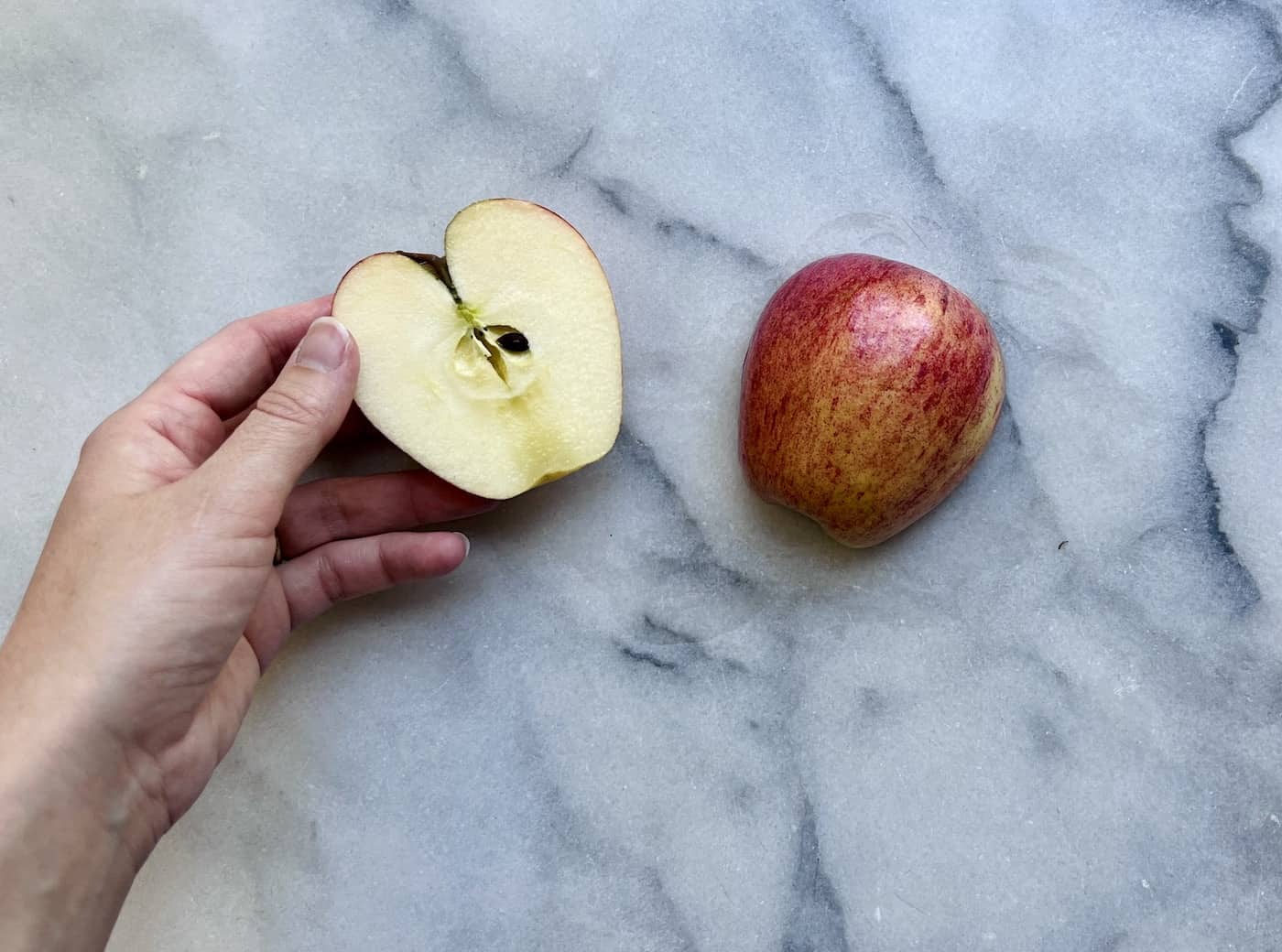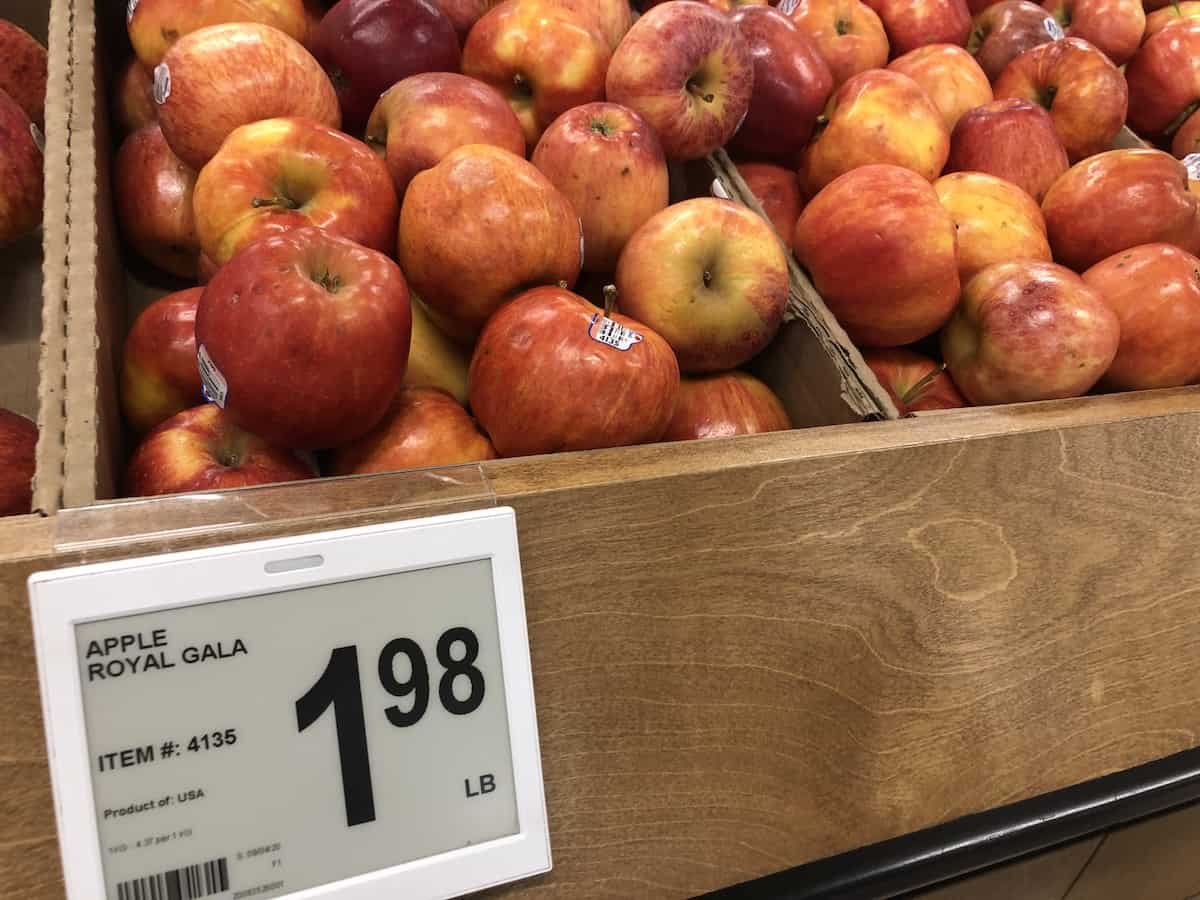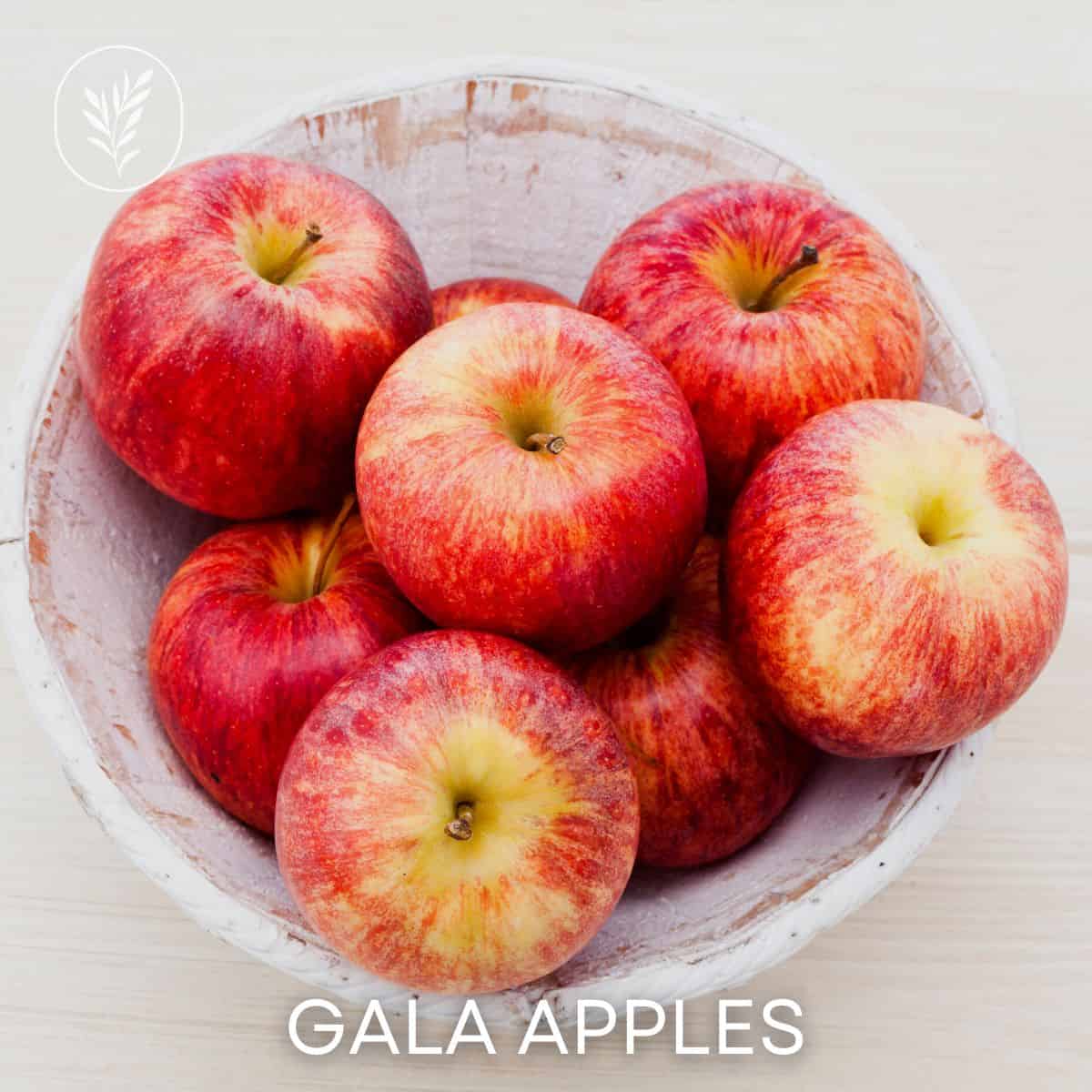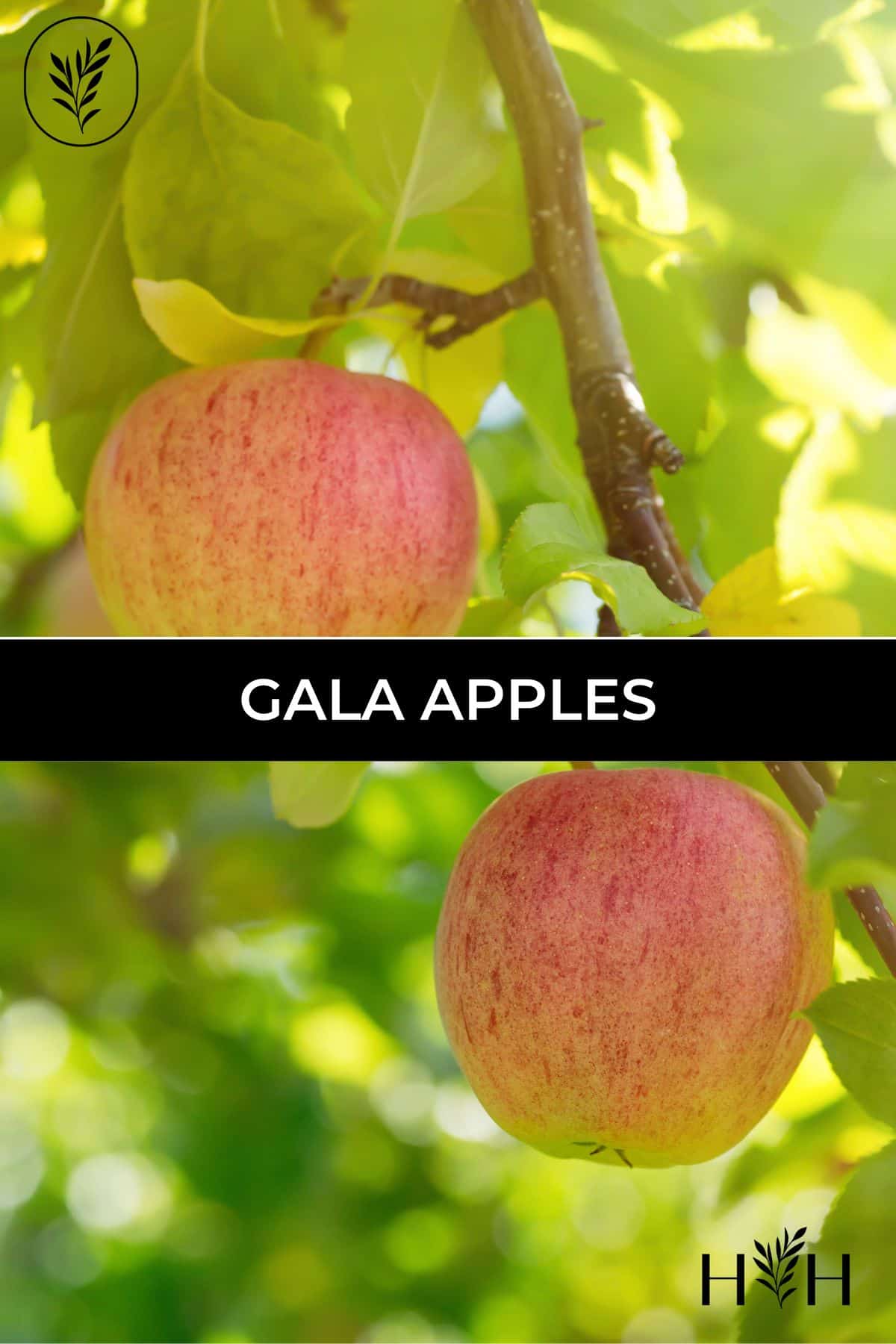Gala Apples have a crisp texture, mildly sweet flavor, and classic beautiful yellow/orange, fine textured skin with red striping. The first gala tree was bred in New Zealand in the 1930s, and these fruits are now worldwide favorites. They are typically available year-round and are the most popular apples in the USA!

Origins of the Gala apple
The first Gala Apple tree was bred by orchardist J.H. Kidd in 1930’s New Zealand. The variety is a cross between Golden Delicious Apples and one of Kidd’s own types, Kidd’s Orange Red Apples, with a floral aroma. Since the first gala apple tree was discovered, orchardists all over the world have planted Gala trees, even propagating the best branches (called “sports”) to produce their own improved strains of Gala with desirable genetic mutations. The Gala Apple is now the most popular type of apple in the world!
“Gala: This variety, a cross between Kidd’s Orange Red and Golden Delicious, originated in New Zealand. The Royal Gala strain was named in honor of Queen Elizabeth II, who deemed it her favorite during a visit to New Zealand. It was brought to the United States in the early 1970s and is now one of the country’s most popular apples.”
Apple Varieties: Gala, US Apple Association
Gala Apple trees were bred through the natural cross-pollination of existing varieties. These apples are not genetically modified (GMO). Varying strains of the Gala variety are naturally occurring genetic mutations rather than the product of genetic engineering.

What do Gala apples taste like?
Gala Apples have a sweet flavor, juicy fine flesh, and thin, fine-textured peel. Their sweet yet crisp taste is one of the main reasons for their soaring popularity. Here are some descriptions of what perfectly-ripe gala apples taste like:
- Creamy, juicy white flesh with a dense, fine texture
- Crisp, succulent fresh-apple snap when eaten fresh
- Subtle, sweet, pear-like taste with slight acidity
- Aromatic hints of vanilla and sweet apple blossoms
Their crisp, sweet taste makes these apples an excellent all-around apple. The cream-colored flesh is somewhat slow to brown after being cut. They’re delicious when eaten fresh and can also be cooked into applesauce or pressed into apple cider.
Their subtle taste pairs well on a charcuterie board with bold cheeses and with full-bodied wines. These sweet apples are also great on a grilled sandwich with brie and caramelized onions. They also contrast nicely with tarter apples, such as the Granny Smith variety.

Harvest season for Gala apples
Harvest season for the Gala starts in mid-July and lasts through the month of September. Gala Apples are grown in warmer areas of the USA and typically ripen first, while those grown in areas with cold climates ripen in September. New Zealand’s apples typically ripen in February-March.
The flavor of a gala apple is best when harvested at optimal maturity. Orchardists leave these apples on the tree until they have reached peak sweetness, but before the flavor has a chance to deteriorate. Galas that are left on the tree tend to have a deeper red blush to their skin, although this is also affected by the climate, fall weather, and the specific genetics of the tree.

Where are Gala apples grown?
Gala Apples have been grown all over the world for decades. This particular variety has flexible growing-climate requirements, making it a viable crop in a wide range of regions. Because they are grown in both the southern and northern hemispheres, these apples are available in grocery stores year-round.
Here are some of the major production areas for Gala Apples:
- USA
- Canada
- Northern China
- Poland
- Chile
- New Zealand
- South Africa


Tips for buying Gala apples
Gala Apples are available year-round at supermarkets and stores such as Kroger, Target, and Walmart. The Gala variety has become the most-produced type of apple in the USA as of 2019.
During harvest season, they are also readily available at farmers’ markets and fruit stands. Freshly-picked local apples tend to have better flavor, texture, and shelf-life than those stored and imported for commercial distribution.
While locally-grown apples are wonderful, there are some times of the year when imported apples are fresher. Apples grown in the Northern Hemisphere typically become available in August-February.
Starting in March, the new crop from the Southern Hemisphere become available. Gala Apples from New Zealand/Chile/South Africa are the freshest from mid-March to early July.
The first of the North American Gala Apples are available again in late July, with the majority of the crop harvested in September. The year-round availability of Galas is another reason for their popularity.
A Gala Apple is medium-sized, and may even be on the smaller end of the apples available at the store (perfect for little kids!). A typical Apple weighs around 6 ounces or 0.35 pounds (150 grams). There are generally 3 apples in a pound of Gala Apples.

Cost of Gala apples
Gala Apples cost about $2 per pound when purchased at the grocery store. Bulk discounts are available when lots of apples are purchased at once. A large ten-pound bag of Galas tends to contain between 25-30 individual apples and may cost $10-$15 at a retailer.
“At the 2019 U.S. Apple Association’s Marketing and Outlook Conference on Aug. 22, gala production was pegged at 50 million (42-pound) cartons, easily above the 45.82 million carton output of red delicious.”
Gala Claims Top Apple Spot, Produce Retailer


How to grow Gala apples
Home gardeners can grow their own Gala Apples with a bit of planning and annual maintenance. Galas can be grown in both cool and warm apple-growing regions, as they do not require as many hours of cold winter temperatures as some other apple varieties (like Honeycrisp Apples, which require cold winters).
These apples can be grown from Washington down to California, Minnesota over to Ohio, and in NY and Pennsylvania. Look for a healthy, locally-grown young tree for the best results in your climate. Gala Apple trees are cold-hardy to Zone 4, surviving temperatures down to -30°F (-34°C)!
“When planting your tree, make sure that the graft union (the bulge where the root stock has been fused onto the scion) is about 5 cm (2 inches) above the soil line. If you bury the graft union, the scion may grow roots and then your tree will not benefit from the positive traits of the rootstock.”
Growing Urban Orchards: How to Care for Fruit Trees in the City and Beyond, by Susan Poizner
Caring for Gala apple trees
The apple blossoms on your Gala Apple tree are best pollinated with pollen from a different type of apple tree. Good pollinator varieties for Gala trees include Golden Delicious, Red Delicious, Honeycrisp, Granny Smith, Cox’s Orange Pippin, and Fuji Apples. A neighbor may already have an apple (or crabapple) tree that flowers at the same time as your new gala tree.
Trees produce the highest number of apples when planted in a sunny area where they will receive 6-8 hours of sunlight each day. Plant new trees as soon as possible in a wide, shallow hole. Water the tree deeply after planting, and continue to water it regularly as its roots become established. A 1″-thick layer of compost can be placed on the soil around the tree as mulch, as long as it doesn’t touch the trunk itself.
Prune Gala Apple trees in March by removing vertical shoots, branches that are crossing/rubbing, and any branches that are dead, dying, diseased, or otherwise damaged. Also, be sure to prune other trees in the area to let in the light. Apple trees need lots of sunlight!
Gala Apple trees in warmer areas like North Carolina tend to bloom in April, while those in northern areas bloom in May. Expect your tree to start blossoming and growing yummy Gala Apples about 3 years after planting! You may wish to remove a portion of the young apples so that the remaining apples grow larger and sweeter with extra attention.
Remember, the better you take care of your apple trees, the likelier that they’ll be able to last year round and produce excellent apples!

Shelf life for ripe Gala apples
Success in storing Gala Apples is largely dependent upon the temperature. A Gala Apple may only keep for a week or two on the counter, while it can keep for 6-8 weeks in the refrigerator (use the crisper drawer). Galas, similar to most apples, can last 4 months in cold storage and can be kept in commercial controlled-atmosphere storage for up to 8 months!
Choose apples that are free from blemishes or bruising, as they will last the longest in storage. Royal Gala apples have thin skin and can be easily checked over for damage. Also, try to choose apples for storage that are at the peak of their ripeness. Over or under-ripe galas don’t store as well. And remember that most apples store best in cool conditions: between 34°-39°F (1°-4°C).

What to make with Gala apples
Gala Apples are excellent all-around apples, meaning they are great for eating fresh AND for use in baking and other cooked recipes. Use your apples to make apple slices, salads, juicing, baked goods, cider, or freeze them for later use.
Baking with Gala apples
Gala Apples are good for baking, particularly when combined with other apple varieties to add some complexity of flavor and fuller texture. The Golden Delicious Apple, which is one of the parent varieties of Gala, makes an excellent pairing when the two types of apples are blended in pies, crumbles, or crisps. These apples can also be combined with Braeburn, Granny Smith, or Spartan apples to make tasty salads, or they can simply be used all on their own!
Gala apple recipes
These recipes are perfect for making with gala apples:
Substitutes for Gala apples
Gala apples are easily substituted with offspring varieties like Jazz, Envy, Kanzi, and Summer free. The apples from which the Gala is descended are also an excellent substitution choice. Gala is a cross between Golden Delicious and Kidd’s Orange Red (which is a cross of Red Delicious and Cox’s Orange Pippin). Any of these parent apples would be a great stand-in for the Gala.











